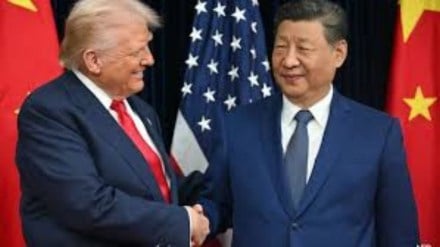US President Donald Trump & Chinese President Xi Jinping have concluded their talks in South Korea with a deal to maintain the flow of China’s rare earth exports to the US. As the world’s two biggest economies try to dominate global trade, we explain why access to these essential elements is so crucial for Washington
Key takeaways from the rare earths deal
Donald Trump and Xi Jinping struck a deal to keep the flow of rare earth minerals to the US unhindered, at a nearly two-hour summit in Busan, South Korea, on Thursday. Trump has said China has agreed on a one-year deal to supply rare earths. “We focused on export controls of China on rare earth, and they’re going to keep those flowing, which is quite important,” Trump said, speaking to reporters on Air Force One. “There is no roadblock at all on rare earths. That will hopefully disappear from our vocabulary for a little while.”
Trump has said he expected the one-year deal to be extended, though China’s commerce ministry said the pause would last for a year. Trump has also said overall US tariffs on Chinese goods would drop from 57% to 47%, due to progress in talks on soyabean imports, rare earths and fentanyl issues. The moves represent a reprieve in the escalating tariff war between the world’s two largest economies. This was the first time that the two leaders had met since 2019.
What makes the agreement on rare earths so crucial?
Rare earth minerals have become China’s most potent source of negotiating leverage thanks to export restrictions introduced this year which allow Beijing to cut off foreign customers dependent on Chinese supply. Following Washington’s decision to hike tariffs on Chinese exports in April, China began imposing restrictions on the exports of seven rare earth minerals. Since then, all companies needed to get special export licenses in order to send rare earths and magnets out of the country. That left the US particularly vulnerable as there is no capacity outside China to process rare earths. In October, China expanded its controls over the export of rare earths.
Foreign companies are now required to have the Chinese government’s approval to export even small amounts of rare earths and must explain their intended use. Though details of the agreement are unclear, the deal will essentially stabilise prices of rare earths and related products for the time being.
Will the deal cover the April curbs?
China has announced it would pause for one year export controls introduced on October 9, when Beijing expanded its rare earth export regime to include new materials and rules, according to a release from the Ministry of Commerce. China’s latest restrictions on the five additional elements and processing equipment are set to take effect on November 8, just before a 90-day trade truce with Washington expires.
According to Reuters, US Trade Representative Jamieson Greer, also speaking on Air Force One, said China would not impose its proposed rare earth controls. He did not mention controls introduced in April. That would mean that the US is still left grappling with the April curbs. Efforts are underway in the US, Europe, and Australia to develop alternative supply chains. But experts believe it will take years before they can meaningfully reduce global dependence on China.
What are rare earths?
Rare earths refer to a group of 17 elements, the 15 lanthanides, plus scandium and yttrium, most of which are silvery-white metals. The 17 rare earth elements are: scandium, yttrium, lanthanum, cerium, praseodymium, neodymium, promethium, samarium, europium, gadolinium, terbium, dysprosium, holmium, erbium, thulium, ytterbium, and lutetium.
Despite their name, rare earths are not scarce in nature, and some are even more abundant than lead. However, they are typically found in low concentrations and mixed with other minerals, making extraction and separation expensive and complex.
Although US scientists pioneered refining techniques for rare earths in the 1950s, China has dominated the global market since the 1980s, aided by lower costs, relaxed environmental rules, and consistent government support. China now accounts for about 60% of the world’s mine output and over 90% of the refined production and magnet manufacturing.
Why hi-tech firms need them?
These elements or the magnets made from them, are essential components in a wide range of modern technologies. They are found in small but crucial amounts in LED lights, smartphones, household appliances, electric vehicles (EVs), medical devices, and advanced military hardware such as missiles, radar systems, and the F-35 fighter jet.
Rare earth magnets are essential in permanent magnet synchronous motors, the core of EV propulsion systems, ensuring high torque density, energy efficiency and reduced size of EV motors. They are used in defence guidance systems, missile actuators, lasers, radar and sonar systems; in consumer electronics, they are utilised in smartphones, speakers and hard drives. Due to their critical role in manufacturing, disruptions in supply can severely impact industries.
Earlier this year, several auto-makers in India were forced to halt production after Chinese export restrictions led to shortages. US President Donald Trump & Chinese President Xi Jinping have concluded their talks in South Korea with a deal to maintain the flow of China’s rare earth exports to the US. As the world’s two biggest economies try to dominate global trade, we explain why access to these essential elements is so crucial for Washington.
